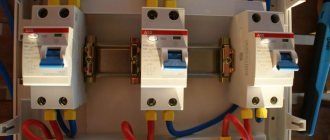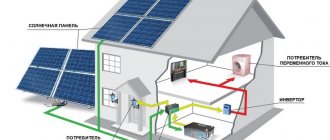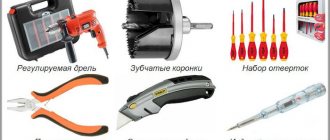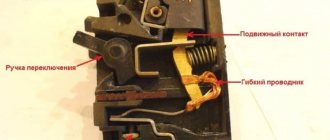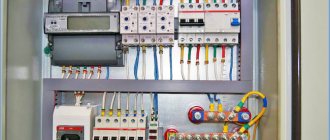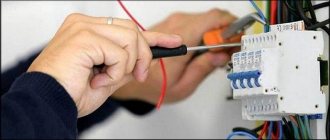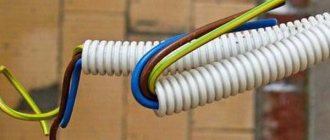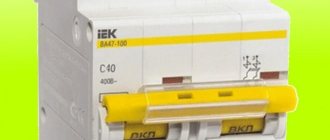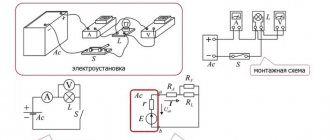How to properly connect an RCD and an automatic circuit breaker is a common question among those people who need to assemble an electrical panel. After all, everyone knows that the main source of power, electricity, is dangerous under certain circumstances. Thus, incorrect connection of automation can result in malfunction of electrical wiring, equipment, or fire, so such actions must be taken responsibly. Today we will look at the features of connecting electrical panel protective devices.
How to properly connect an RCD and a machine
The need to protect the electrical network
The electrical system of an apartment is a complex network with many branches - sockets, switches, power and low-current circuits. This includes any electrical installations that we use every day.
When using various devices powered by electricity, problems often occur, due to which malfunctions of circuits and devices occur, and sometimes even tragic situations occur. There are certain preconditions for such consequences:
- excessive load on individual lines;
- leakage current;
- short circuits.
Short circuit causes fire
Excessive load on the line often occurs when using energy-intensive electrical appliances with outdated wiring. So, the cable cannot withstand the load, which is why it heats up and melts.
Current leakage occurs when the insulating layer of conductors and electrical appliances wears out. In addition, this happens when there are errors in the installation, namely the grounding cable.
The presence of an RCD will protect against the consequences of current leakage
The impact of a current of more than 1.5 mA becomes noticeable to a person. Significantly exceeding this indicator leads to shocks.
In order to preserve the integrity of electrical equipment and the lives of apartment owners, it is necessary to install emergency power shutdown devices. It is worth noting that their absence is unacceptable, otherwise the power grid will be considered dangerous.
Features of load shedding devices
If the electrical system is divided into circuits, then a separate circuit breaker is installed for each line in the chain, and a protection device is installed at the output. However, there are many connection options. Therefore, first you need to understand the differences between RCDs and other automation.
Circuit breakers - improved “plugs”
Years earlier, when there were no modern network protection devices, when the load on the common line increased, “traffic jams”—the simplest devices for emergency power outages—triggered.
Over time, they were significantly improved, which made it possible to obtain machines that operate in the following situations - in the event of a short circuit and excessive load on the line. The general electrical panel may contain from one to several circuit breakers. The exact number will differ depending on the number of lines that are available in a particular apartment.
It is worth noting that the more separate electrical wiring lines there are, the easier it is to carry out repair work. After all, in order to install one device, you do not need to disconnect the entire electrical network.
Automatic switches are used instead of outdated traffic jams
Installation of automation is a mandatory stage in assembling an electrical panel for home use. After all, switches instantly react to network overload when a short circuit occurs. However, they do not protect the system from current leakage.
Prices for protective automation
Protective automation
RCD – automatic protection devices
RCD is a device that is responsible for controlling current strength and preventing its loss. In appearance, the protective device is not fundamentally different from the circuit breaker, but it functions differently.
RCD in the electrical panel
It is worth noting that this is a multi-phase device that operates at voltages of 230/400 V and currents up to 32 A. However, the device also operates at lower values.
Devices labeled 10 mA are sometimes used to route the line into a room with high humidity levels. There are two main types of RCDs. In order to choose the appropriate option, you need to consider them in more detail.
Table No. 1. Types of RCD.
| View | Description |
| Electromechanical | Here the main functioning device is a magnetic circuit with windings. Its job is to compare the level of current that goes into the network and then returns. |
| Electronic | This device allows you to compare current values, but only here the board is responsible for this process. However, it only functions when voltage is present. |
It is worth noting that the electromechanical device is more popular. After all, if a consumer accidentally touches a phase conductor while the board is de-energized, he will receive an electric shock. While the electromechanical RCD will remain operational.
It turns out that the RCD only protects the system from current leakage, but it is considered useless at increased line voltage. It is for this reason that it is mounted only in combination with a circuit breaker. Only these two devices will provide complete protection of the electrical network.
Prices for various types of RCDs
RCD
What is a difavtomat and how does it differ from an RCD?
If we talk about how a difavtomat differs from the previous device, then it is necessary to take into account its combination with a circuit breaker. After all, in fact, a differential circuit breaker is a combination of these two devices only in a single housing.
This device performs the following functions:
- protects against current leakage;
- prevents excessive loads on the line;
- Immediately cuts off power in the event of a short circuit.
Difavtomats are universal devices
Despite the fact that the device is miniature, it works in seconds, but only if it is well assembled by a reliable manufacturer. On its body you can find basic markings that will help you make your choice.
Here, as on the RCD body, the load/leakage current is indicated, which is measured in mA.
Some users may think that the creation of a difavtomat should be a reason to stop using the machine and RCD. Nevertheless, both options remain in demand today.
Prices for various types of automatic machines
Difavtomat
Video - Which is better RCD or differential circuit breaker?
Types and dimensional characteristics of electrical panels
Now let’s talk about cabinets/drawers for mounting machines and their varieties. Depending on the type of installation, electrical panels can be external or internal. The box for external installation is attached to the wall with dowels. If the walls are flammable, a non-conductive insulating material is placed underneath. After installation, the outer shield protrudes above the wall surface by about 12-18 centimeters.
This must be taken into account when searching for a place to install it. Usually, for ease of maintenance, the electrical panel is installed in such a way that all its parts are placed at face level. This will make it more convenient for you, but it can lead to a dangerous situation (the corners are sharp), so be careful. A suitable option for placement is behind the door or closer to the corner.
What types of RCDs and differential circuit breakers are there based on the type of current leakage?
Electrical circuits use different types of currents, which is why protective devices are usually divided into classes:
- AC type. This is a common class of devices that have a budget price, so they are often used in apartments and country houses. They are calculated for the leakage of alternating current, on which most household appliances operate.
- Type A. Allows you to detect both AC and DC leakage. In recent years, manufacturers have begun to produce devices adapted specifically for such RCDs. Switching power supplies are used here to regulate power. Since these are more reliable devices, they cost a little more than the previous ones.
- Type B. These RCDs also react to any current leakage. However, they are often used only at production facilities and in public places. It makes no sense to install them in an apartment.
The marking by which the class is determined is located on the body of the device
Connection methods in a private house or apartment
If you decide to install a protective device in an apartment or private house, then you need to select the parameters in accordance with the rules. First of all, you need to look at the possibility of current loading and why the device is selected in principle.
If you need to install protection on a single electrical appliance, for example, a washing machine, then you can purchase a device with a minimum rated current. If the RCD is installed in the entire apartment, then you must first add up the load of each consumer, and then select the appropriate option. Another value is the differential current, which increases when the protective mechanism is triggered. After that, all that remains is to install the RCD.
Connection diagram
If you look at the presented diagram, you can see that the protective device is installed after the input circuit breaker and the electric meter. Then, after the RCD, the phase conductor goes to the circuit breakers, which are responsible for controlling groups of different loads. Next, the conductor goes to energy consumers (lamps, sockets).
Along the zero line, the cable goes to the clamping blocks, and then branches out to consumers. In this image there is no zero bus, which is often found in apartments and houses of early years of construction. A scheme using several protective devices at each point of consumption will be relevant here.
Features of connecting to a single-phase network of single-pole and four-pole protective devices
Based on the diagram presented above, it will not be difficult to connect a single-pole RCD, because this is the simplest and most popular option if you have a single-phase network. Thus, installation can be done both in an apartment and in a private house.
The main thing here is not to confuse the connection points of the zero and phase wires. Most often, the designation “1” is used for the incoming phase cable, and “2” for the outgoing phase. Neutral is usually designated “N”.
Important point! A four-pole RCD is extremely rarely used for a single-phase network, because it is impractical. It is installed only in the case of a temporary device or if further upgrading to a three-phase network is necessary.
Next, you have to act on the same principle as in the case of a single-pole device. To do this, the neutral is connected to a terminal marked “N”. The phase wire is connected to the terminal in a chain where the “Test” button is turned on. Most often it is located next to the neutral circuit. Using this button, you must check the serviceability of the equipment at least once every 30 days.
Four-pole protective device
Let's move on to connecting the circuit breaker
If there is voltage on your supply wire, it must be turned off before starting work. Then make sure there is no voltage on the connected wire using a voltage indicator. For connection we use VVGngP 3*2.5 three-core wire, with a cross-section of 2.5 mm.
We prepare suitable wires for connection. Our wire has double insulation, common outer and multi-colored inner. Let's decide on the connection colors:
- blue wire – always zero
- yellow with green stripe – earth
- the remaining color, in our case black, will be the phase
Phase and neutral are connected to the terminals of the machine, ground separately to the feed-through terminal. We remove the first layer of insulation, measure the required length, and bite off the excess.
Unscrew the contact screws and insert the wires into the contacts of the machine. We connect the phase wire on the left, and the neutral wire on the right. Outgoing wires should be connected in the same way. After connecting, be sure to check again. Care must be taken to ensure that the wire insulation does not accidentally get into the clamping contact, as this will cause the copper core to have poor pressure to the machine contact, which will cause the wire to heat up, the contact to burn, and the result will be failure of the machine.
We inserted the wires, tightened the screws with a screwdriver, now you need to make sure that the wires are securely fixed in the contact clamp. We check each wire separately, swing it a little to the left, to the right, pull it up from the contact, if the wire remains motionless, the contact is good.
In our case, a three-wire wire is used; in addition to phase and zero, there is a grounding wire. In no case is it connected through a circuit breaker; a feed-through contact is provided for it. Inside, it is connected by a metal bus so that the wire passes without breaking to its final destination, usually sockets.
If you don’t have a feed-through contact at hand, you can simply twist the incoming and outgoing wires together using a regular twist, but in this case you need to pull it well with pliers. An example is shown in the picture.
The feed-through contact is installed as easily as a machine; it snaps onto the rail with a slight movement of the hand. We measure out the required amount of grounding wire, bite off the excess, remove the insulation (1 centimeter) and connect the wire to the contact.
Do not forget to make sure that the wire is well fixed in the contact clamp.
Suitable wires are connected.
If the circuit breaker trips, the voltage remains only on the upper contacts; this is completely safe and is provided for in the circuit breaker connection diagram. The lower contacts in this case will be completely disconnected from the electric current.
We connect the outgoing wires. By the way, these wires can go anywhere to a light, an outlet, or directly to equipment, for example, to an electric water heater or electric stove.
We remove the outer insulation and measure the amount of wire required for connection.
We remove the insulation from the copper conductors and connect the wires to the machine.
Prepare the ground wire. We measure out the required amount, clean it, connect it. We check the reliability of fixation in contact.
The connection of the circuit breaker has come to its logical conclusion, all wires are connected, and voltage can be applied. At the moment, the machine is in the down position (off), we can safely apply voltage to it and turn it on, to do this we move the lever to the up position (on).
By connecting the circuit breaker with our own hands, we saved:
- calling an electrician – 200 rubles
- installation and connection of a two-pole circuit breaker – 300 rubles
- DIN rail installation – 100 rubles
- installation and connection of a feed-through grounding contact 150 rubles
TOTAL: 750 rubles
*The cost of electrical installation services is shown in the pricing table
Where to install?
As a rule, the protective device is installed in an electrical panel, which is located on the landing or in the residents' apartment. It contains many devices that are responsible for metering and distributing electricity up to a thousand watts. Therefore, in one panel with an RCD there are machines, an electric meter, clamping blocks and other devices.
If you already have a shield installed, then installing the RCD will be easy. To do this, you will only need a minimal set of tools, which includes pliers, wire cutters, screwdrivers and a marker.
The process of installing automation in an electrical panel: step-by-step instructions
Let's consider the option of assembling an electrical panel for a one-room apartment; a switch, a protective multifunctional device will be used here, then a group of RCDs will be installed (type “A” for a washing machine and dishwasher, because such a device is recommended by the equipment manufacturer). After the protective device there will be all groups of circuit breakers (for air conditioning, refrigerator, washing machine, dishwasher, stove, and also for lighting). In addition, pulse relays will be used here; they are needed to control lighting devices. A special module for wiring will also be installed in the panel, which resembles a junction box.
Step 1: first, you need to place all the automation on the DIN rail, in the way we will connect it.
This is how the devices will be located in the panel
In the panel there is first a switch, then an UZM, four RCDs, a group of circuit breakers of 16 A, 20 A, 32 A. Next are 5 pulse relays, 3 lighting groups of 10 A and a module for connecting the wiring.
Step 2: Next we need a two-pole comb (to power the RCD). If the comb is longer than the number of RCDs (in our case, four), then it should be shortened using a special machine.
Cut the comb to the required size, and then install stops along the edges
Step 3: Now all RCDs should be fed together by installing a comb. Moreover, the screws of the first RCD should not be tightened. Next, you need to take cable sections of 10 square millimeters, remove the insulation from the ends, make crimping with lugs, and then connect the switch to the UZM, and the UZM to the first RCD.
This is what the connections will look like
Step 4: next you need to supply power to the switch, and accordingly to the UZM with the RCD. This can be done using a power cable, which has a plug at one end and two crimped wires with tips at the other. Moreover, you first need to insert the crimped wires into the switch, and only then make a connection to the network.
Next, all that remains is to connect the plug, then set the approximate range on the UZM and click on the “Test” button. So, you can check the functionality of the device.
Here you can see that the UZM is functioning, now you need to check each RCD (if connected correctly, it should turn off)
Step 5: Now you need to turn off the power and continue assembly - you should power the group of circuit breakers on the central rail with a comb. Here we will have 3 groups (the first is the hob/oven, the second is the dishwasher and washing machine, the third is the sockets).
We install the comb on the machines and transfer the slats to the panel
Step 6: Next you need to move on to the zero buses. There are four RCDs installed here, but only two zero buses are required, because they are not required for 2 groups. The reason for this is the presence of holes in the machines not only at the top, but also at the bottom, so we will connect the load to each of them, so a bus will not be required here.
In this case, you will need a cable of 6 square millimeters, which must be measured in place, stripped, clamped at the ends and connected to the RCD with its groups.
Using the same principle, it is necessary to power the devices with phase cables
Step 7: since we have already connected the automation, all that remains is to power the pulse relays. They should be connected to each other with a 1.5 square millimeter cable. In addition, the machine phase should be connected to the junction box.
This is what the assembled shield will look like
Next, you need to take a marker to mark the groups for which this or that equipment is intended. This is done in order to avoid confusion in case of further repairs.
Safety precautions when working with RCDs and automatic machines
Video - How to connect an RCD
How to check an RCD in 30 seconds
After the installation of the RCD and circuit breaker connection diagram has been completed, it is necessary to check the operation of the protective devices. To check the operation of the RCD, press the button. If the power turns off when pressed, then everything is in order and the device is working. It is recommended to perform such a check periodically to ensure the operation of the device.
The second method is not recommended to be used independently. It is used by professionals. The phase, through a resistor, is connected to the ground wire. In this way, a controlled leakage of current is carried out.
It is not always possible to use the services of a professional electrician, and you have to do the work yourself. In this case, remember and strictly follow the safety rules.
We have looked at several basic schemes for connecting protective devices; in practice there can be much more.
If you are professionally involved in electrical installation work and can give useful advice or suggest other connection diagrams, write to us in the comments.
Mistakes that electricians make when connecting automation
It is worth noting that equipment often fails prematurely due to the following errors during installation work:
- Incorrect connection of output contacts. The neutral conductor is often confused with the neutral conductor.
- Supplying supply voltage to the bottom of the device leads to loss of operation of the device.
- It is prohibited to connect the outputs of the neutral conductors of several devices with each other. This causes the device to lose sensitivity. Because of this, the RCD does not turn off the power when a danger occurs.
- You should not connect the neutral wire to the ground wire in the socket, which also provokes interruptions in operation.
- Power contacts are not allowed to be connected from different sides.
For example, the power phase is at the bottom, and the outgoing zero is at the top. This will also lead to the equipment not functioning properly. Every electrician should know the rules for connecting an RCD!
Every electrician should know the rules for connecting an RCD!
If you follow the instructions, you will be able to connect circuit breakers and protective devices in the panel without the help of a professional electrician. However, all actions should be performed step by step, slowly, to eliminate mistakes. You can read more about connecting machines in an electrical panel in our special article.
The machines in one group are connected by jumpers: the common phase arrives
There are two ways to make jumpers:
- Cut the conductors into the required sections, expose their edges and bend them in an arc. Insert two conductors into one terminal, then tighten.
- Take a long enough conductor and strip off 1-1.5 cm of insulation every 4-5 cm. Take pliers and bend the exposed conductors so that you get interconnected arcs. Insert these exposed areas into the appropriate sockets and tighten.
They do this, but electricians say the quality of the connection is poor. It is safer to use special tires. Under them on the case there are special connectors (narrow slots, closer to the front edge), into which bus contacts are inserted. These tires are sold by the meter and cut into pieces of the required length using ordinary wire cutters. Having inserted it and installed the supply conductor in the first of the machines, tighten the contacts on all connected devices. Watch the video on how to connect machines in a panel using a bus.
A phase wire is connected to the output of the machines, which goes to the load: to household appliances, to sockets, switches, etc. Actually, the assembly of the shield is completed.
